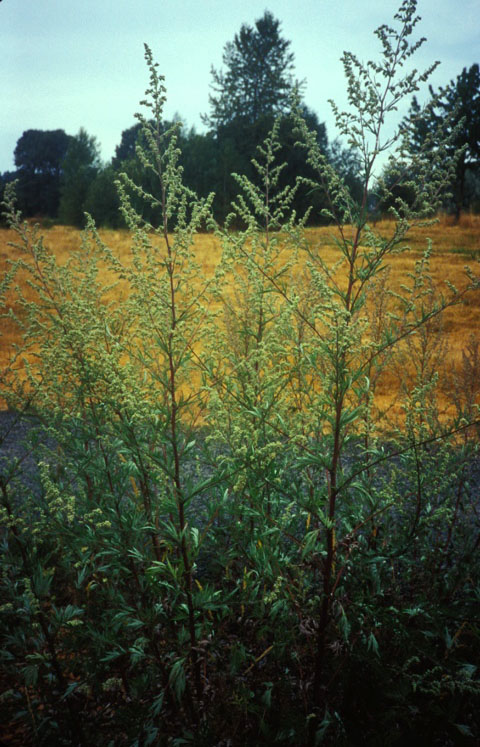
|
| Mugwort; Artemisia vulgaris L. |
Sunflower Family; COMPOSITÆ (ASTERACEÆ)
|
| Last month we featured another wort, St. John's. This time our highlighted wort is decidedly more pagan: associated
with beer-drinking, no less, yet coincidentally also associated with St. John. Mugwort is tall, lean, aromatic, and unique in its
memorable name. It is one of those plants not compared visually to others, because it is so distinctive in its own right. Although it is not a
serious pest, nor especially difficult to control, Mugwort should still be learned by all who desire awareness of wild plants. Besides
growing wild, it is a standard in herb gardens, and also is used in herbal medicine, so is worth deeper acquaintance. |
| After a winter of dormancy, Mugwort roots send forth clumped stems, which grow taller and taller, until late July they
begin opening their tiny flowers. In the fullness of its August bloom it wins no beauty contest, as its florets, however numerous, are
minute and dull. But the impressive height of the full-grown stems being sometimes more than 10 feet, and the dark foliage, at once bold
and elegant, draw attention. Each leaf is deeply cleft into segments suggestive of a giant hawthorn leaf, dark green on top, and
cottony white or grayish (in age) underneath. If the flowers were not so dinky, the herb might make a spectacular garden ornamental, with
its arched clumps of purplish, grooved, leafy stems. |
| The other species of Artemisia cultivated for their attractive foliage, fragrance, or medicinal value, also have
insignificant-looking flowers: Tarragon, Wormwood, Sagebrush, Southernwood, Silver Mound,
etc. Each has a warm smell, very pleasing
to inhale. Alas, Mugwort is about the weakest-smelling of the lot, and as coarse-looking as any. Taste some, and you will find it
mild-flavored, but texturally like chewing a cat's fur-ball or a piece of leather. Too bad: study has revealed Mugwort is an
extraordinary vegetable source of niacin and protein. However, even if it wasn't so hairy, eating much might be harmful, as it is potent in
medical constituents. |
| Mugwort grows in sunny, usually dry places. No site is too harshly exposed for it. It is native in the Old World but
cultivated in so many countries that its original homeland is uncertain. The plant is grown occasionally for fragrance, for flavoring, and
for its medicinal properties. The name Mugwort refers to its ancient use in flavoring beer, traditionally partaken from
mugs. Sailor's Tobacco is another name. Other uses are few, such as the
moxa of east Asian medicine. The down coating its leaf undersides has
been employed as a tinder. |
If you wish to grow some to sniff or nibble, I advise giving it enough room, for it grows as large as fennel or similar
huge herbaceous plants, and do not let it ripen seeds, as one plant is plenty.
|
Originally published as the Seattle Tilth newsletter Weed of the Month in August 1993, along with an illustration from a book.
Back |
|
|

